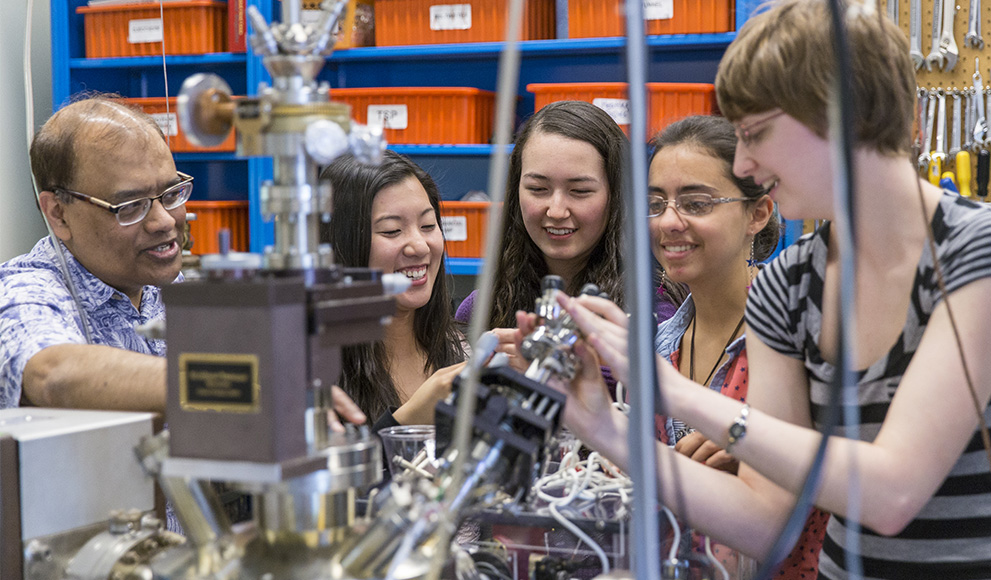Wellesley Professor, Student Present on the “Chemistry of the Heavens” at the American Astronomical Society Conference

Chris Arumainayagam, professor of chemistry, was selected to participate in a press briefing at the American Astronomical Society (AAS) national conference in San Diego, the only professor representing a liberal arts college to do so. He announced findings yesterday, Monday, June 13.
Arumainayagam's work is the first systematic study to demonstrate that early building blocks of life may be produced when low-energy electrons interact with cosmic (interstellar, planetary, and cometary) ices. His recently published results suggest that low-energy, electron-induced condensed phase reactions may contribute to the interstellar synthesis of prebiotic molecules previously thought to form exclusively via UV photons—to simplify, his work is consistent with the idea that we really do come from stardust and is relevant to the first unambiguous detection of glycine in a comet, reported in May 2016.
One of Arumainayagam's students, Jyoti Campbell '18, is taking a break from her summer work at the Jet Propulsion Lab (NASA) to attend the conference and will give a presentation entitled "The Role of Low-Energy Electrons in Astrochemistry: A Tale of Two Molecules." Campbell, a chemical physics major with an astronomy minor from Boulder, Colo, said Arumainayagam's lab is "unique in that it draws on multiple departments." She explained: "I use what I have learned in astronomy courses to understand the conditions we are trying to model and recognize the broader context of the work. I draw on my knowledge of physics to understand the engineering and design of our vacuum chamber. I draw on the chemistry I have taken to understand what we are studying within the chamber." Campbell said it all comes to together "while getting hands-on research experience."
The majority of Arumainayagam's research is conducted entirely on campus with undergraduate students using a state-of the-art ultrahigh vacuum (UHV) chamber, which incorporates many custom-built components. He is currently upgrading his UHV chamber to explore fundamental differences between chemical reactions initiated by photons and electrons.
"My students learn to perform helium leak checks, change oil in vacuum pumps, build electronic circuits, spot-weld difficult junctions, and perform sophisticated computer modeling—hands-on work, especially important for prospective scientists," he explained. "Because I strongly believe that the best means of inspiring students is to involve them in undergraduate research in which they can participate directly in the process of scientific discovery," he added, "I often recruit my research students from first-year students enrolled in my introductory chemistry course."
The goal of Arumainayagam's research is to understand the "chemistry of the heavens" by recreating what happens in interstellar space when high-energy cosmic rays (some with energies much higher than could be produced by the Large Hadron Collider) impact ices (containing water, methanol, and ammonia) surrounding micron-size dust grains in dark dense molecular clouds, where the pressure is ten trillion times lower than that of atmospheric pressure. The interaction of high-energy cosmic rays with matter produces copious numbers of low-energy electrons.
Arumainayagam's results demonstrate that low-energy electron and UV irradiation of methanol ices yield essentially the same reaction products. However, his studies to date have also identified one possible electron-induced cosmic ice chemistry tracer, methoxymethanol, a "complex" organic molecule not identified in UV laboratory photolysis studies of condensed methanol. Future astronomical identification of methoxymethanol within interstellar and/or circumstellar clouds could provide additional evidence for the role of low-energy electrons in astrochemistry. His findings illustrate an urgent need for astrochemical models to include the details of low-energy electron-induced reactions in addition to those driven by UV photons.
Arumainayagam's research has been supported by grants from the National Science Foundation, American Chemical Society, Research Corporation, and the Camille and Henry Dreyfus Foundation.
